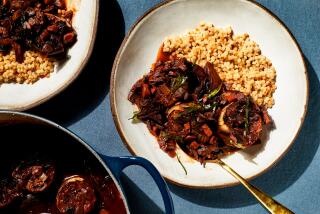The Purple Passion : Not many local growers cultivate the dark, shiny fruit. A few can be found at farmers’ markets.
- Share via
A deep purple, portly fruit hangs on the stem of a short, tree-like plant and is easily recognizable. Yet, while everyone knows it as an eggplant, not many realize that its versatility reaches beyond a couple of familiar culinary uses.
More than the staple for eggplant Parmesan, the sponge-like flesh can be seasoned with any number of chosen embellishments to accent its slightly sweet, yet bland, taste. Although a few different hybrids are available, they all taste pretty much the same and lend themselves to a variety of preparations--be it grilled, fried, or even roasted and stuffed.
Most commonly seen in grocery stores is the standard Black Beauty. Nowadays this large, somewhat squat variety is being nudged aside on some produce racks to make space for the “specialty” types, including the slender Japanese eggplant. If your local grocer isn’t carrying these varieties, we suggest a trip to an area farmers’ market.
Eggplant propagation in Ventura County is mainly left to the small grower, and a few of them sell their crops at the popular outdoor bazaars.
Russ DiLando of Ojai has planted an impressive selection of eggplant, which he will be offering at Ventura’s Saturday farmers’ market.
“I tried growing a small amount of eggplant last year and was successful so I decided to expand it,” DiLando said. “It’s one of my big items this year.”
One of his more unusual varieties is a hybrid he calls the “Ghostbuster.” This oval, white-skinned eggplant ranges from 5 to 8 inches long. Beginning June 27, DiLando will also offer the “Orient Express.” Slender and glossy black, this Japanese variety is ideal for stuffing and baking, as is the Ghostbuster. These smaller versions have a somewhat more delicate favor than their larger relatives.
DiLando, a certified organic grower, finds farming eggplant without the use of pesticides an arduous undertaking. His chief antagonist: the minute flea beetle. “You can’t believe it,” he lamented. “They can eat a foot-tall plant down to nothing in a hurry.”
Because there are no beneficial insects that feed on the insatiable flea beetle, the vulnerable plants must be covered by a thin woven material.
“You’re stuck with just trying to keep them off the plant,” he said.
Frequent weeding is a must, so every time the groomed rows need tending, the paper towel-like fabric must be carefully pulled off, then replaced when finished. Time-consuming to say the least. “That’s why you don’t see much organically grown eggplant,” he said.
DeWayne Boccali raises the eggplant that he prepares for patrons of his Boccali’s Restaurant near Ojai. Beginning in mid July, Boccali’s surplus eggplant, grown in a large garden, will be available, along with a variety of veggies, at an on-site stand.
For good eggplant Parmesan, Boccali said the oil you use is key.
“Olive oil only,” he said. “It’s only as good as the olive oil you use. That’s a big part of great eggplant Parmesan.”
Boccali slices his Black Beauty fruits into “steaks,” smothers them with egg batter and bread crumbs and sautes them in a hot skillet of premium olive oil. He then transfers them to a casserole dish and adds layers of cheeses, sauce and bakes them through until the cheese melts. “It’s a good vegetarian item. It’s just like a meat,” he said.
The slender Japanese variety can be used for an easy-to-prepare hors d’oeuvre, Boccali said. After slicing, simply fry until tender--in olive oil, of course--and serve with ranch dressing.
You’ll find that some recipes suggest salting sliced eggplant before cooking to extract bitterness. The source of the potential bitterness is the seeds, which have a high water content. A brief sitting period after salting allows the water--and any bitterness--to draw out. It is usually the older, more mature eggplant that requires this treatment.
“The bitterness comes from the plant being under stress, such as not having been watered enough,” he said. “People say that you need to do this, but I don’t. I don’t feel I need the extra salt on the food. Everyone still tells me I have great eggplant.”
SERVING SUGGESTION / QUICK SAUTEED EGGPLANT
1 (1 pound) eggplant
2 to 3 tablespoons olive oil
Salt
Freshly ground pepper
1/2 teaspoon dried thyme
Cayenne pepper
2 tablespoons chopped parsley or cilantro
Cut eggplant in 3/4-inch cubes. Heat 2 tablespoons olive oil in a large, heavy skillet or saute pan over medium heat. Add eggplant cubes and season to taste with salt and pepper. Saute, stirring, three to four minutes. Sprinkle with thyme and cayenne.
Cover and cook over medium-low heat, stirring often, seven or eight minutes or until eggplant is tender. Adjust seasonings to taste. Sprinkle with bit more oil, if desired. Gently stir in parsley or cilantro before serving. Makes three to four servings.
Variation: Quick Sauteed Eggplant With Mushrooms:
Cut eight ounces of fresh mushrooms into thick slices. Saute in 1 tablespoon olive oil in skillet until soft. Remove to plate. Saute eggplant, cover and cook as above, adding mushrooms a minute or so before eggplant is tender.
NOT-SO-SLIM PICKINS
Local growers offer these tips to purchasing fresh, sweet eggplant:
* Look for eggplants that are free of blemishes with firm, taut, glossy skin.
* Choose one that feels weighty.
* Cook eggplant within two days of purchase.
* A fresh eggplant probably doesn’t need peeling, but if the skin feels tough, cut it off.
More to Read
Eat your way across L.A.
Get our weekly Tasting Notes newsletter for reviews, news and more.
You may occasionally receive promotional content from the Los Angeles Times.










